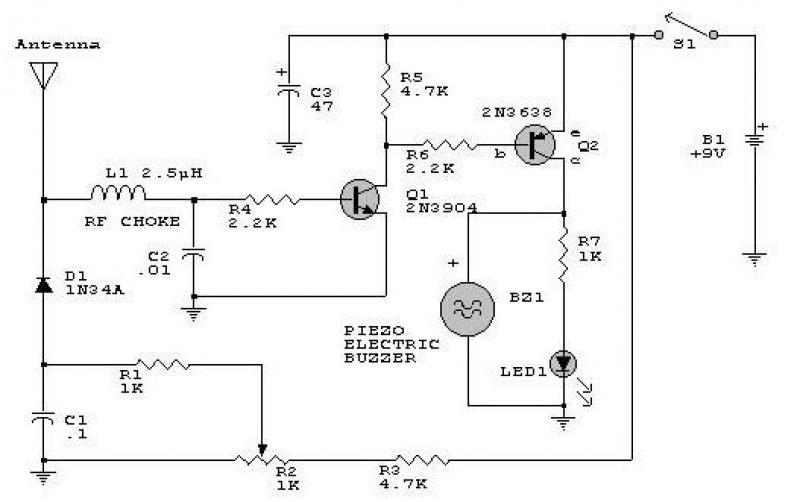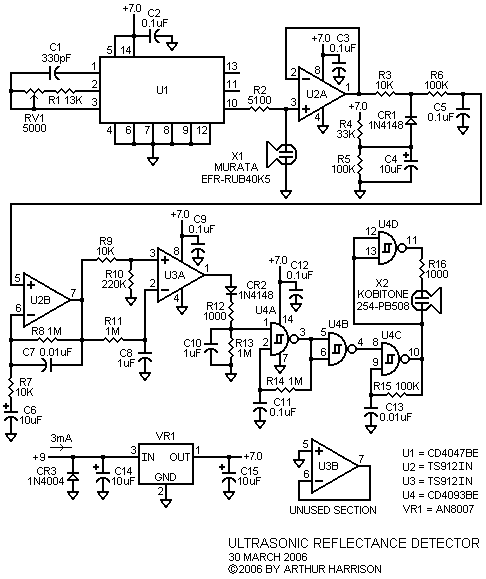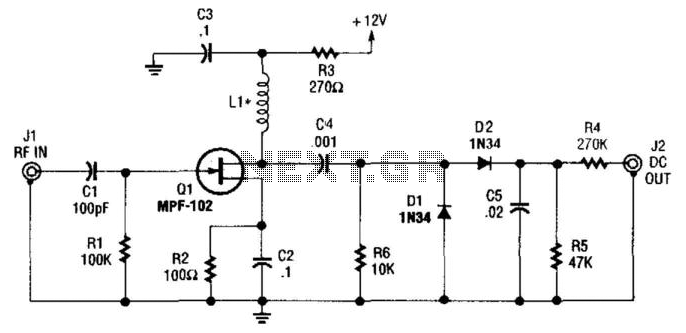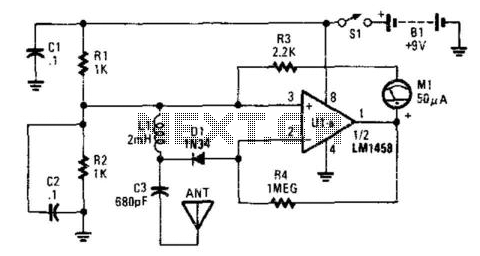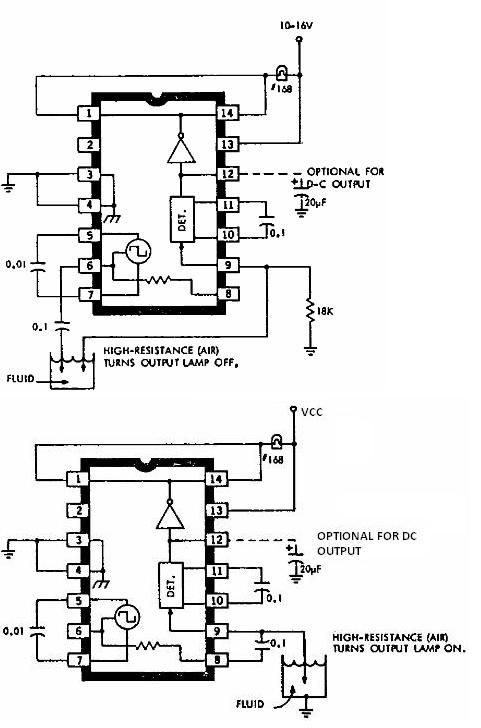
Resistance-ratio detector

Applications such as photoelectric control, temperature detection, and moisture sensing require a circuit that can accurately detect a given resistance ratio. A simple technique that uses an operational amplifier as a sensing element can provide 0.5% accuracy with low component costs. The reed relay contacts close when the resistance of the sensor Rp equals 47% of the standard resistance Rs. Adjusting either Rl or R2 allows for a variable threshold, which is controlled by varying R3. The type of resistors used for Rl and R2 primarily determines the accuracy and stability of the circuit. With metal-film resistors, less than a 0.5% change in ratio sensing occurs over the commercial temperature range (0 to 70 °C) with AC input variations from 105 to 135 V.
The described circuit employs an operational amplifier (op-amp) configured in a feedback arrangement to serve as a precise resistance measurement tool. The op-amp operates in a differential mode, where it compares the voltage across the sensor resistance (Rp) to a reference resistance (Rs). When the ratio of Rp to Rs reaches the specified threshold of 47%, the op-amp outputs a signal that activates the reed relay, thus closing the circuit.
Resistors Rl and R2 are strategically placed in the circuit to allow for fine-tuning of the threshold level. By adjusting these resistors, the sensitivity of the circuit can be modified to suit specific applications. R3 serves as a variable resistor, enabling dynamic adjustment of the threshold level, which is crucial for applications requiring precise detection of resistance changes.
The choice of resistors is critical for maintaining the accuracy and stability of the circuit. Metal-film resistors are recommended due to their excellent temperature coefficient and low noise characteristics. They exhibit minimal variation in resistance over a wide temperature range, ensuring reliable performance in environments where temperature fluctuations may occur. The specified operating temperature range of 0 to 70 °C ensures that the circuit can be utilized in standard commercial applications without significant drift in performance.
The design also accommodates variations in AC input voltage, with the circuit maintaining functionality within the range of 105 to 135 V. This robustness against input fluctuations further enhances the reliability of the circuit in real-world applications. Overall, this sensing circuit is well-suited for various applications, including photoelectric control, temperature detection, and moisture sensing, where precise resistance measurement is essential.Applications such as photoelectric control, temperature detection and moisture sensing require a circuit that can accurately detect a given resistance ratio. A simple technique that uses an op amp as a sensing element can provide 0,5% accuracy with low parts cost.
The reed-relay contacts close when the resistance of the sensor Rp equals 47% of the standard Rs. Adjusting either Rl or R2 provides a variable threshold; the threshold is controlled by varying R3. For the most part, the type of resistors used for Rl and R2 determines the accuracy and stability of the circuit. With metal-film resistors, less than 0.5% change in ratio sensing occurs over the commercial temperature range (0 to 70 C) with ac input variations from 105 to 135 V. 🔗 External reference
The described circuit employs an operational amplifier (op-amp) configured in a feedback arrangement to serve as a precise resistance measurement tool. The op-amp operates in a differential mode, where it compares the voltage across the sensor resistance (Rp) to a reference resistance (Rs). When the ratio of Rp to Rs reaches the specified threshold of 47%, the op-amp outputs a signal that activates the reed relay, thus closing the circuit.
Resistors Rl and R2 are strategically placed in the circuit to allow for fine-tuning of the threshold level. By adjusting these resistors, the sensitivity of the circuit can be modified to suit specific applications. R3 serves as a variable resistor, enabling dynamic adjustment of the threshold level, which is crucial for applications requiring precise detection of resistance changes.
The choice of resistors is critical for maintaining the accuracy and stability of the circuit. Metal-film resistors are recommended due to their excellent temperature coefficient and low noise characteristics. They exhibit minimal variation in resistance over a wide temperature range, ensuring reliable performance in environments where temperature fluctuations may occur. The specified operating temperature range of 0 to 70 °C ensures that the circuit can be utilized in standard commercial applications without significant drift in performance.
The design also accommodates variations in AC input voltage, with the circuit maintaining functionality within the range of 105 to 135 V. This robustness against input fluctuations further enhances the reliability of the circuit in real-world applications. Overall, this sensing circuit is well-suited for various applications, including photoelectric control, temperature detection, and moisture sensing, where precise resistance measurement is essential.Applications such as photoelectric control, temperature detection and moisture sensing require a circuit that can accurately detect a given resistance ratio. A simple technique that uses an op amp as a sensing element can provide 0,5% accuracy with low parts cost.
The reed-relay contacts close when the resistance of the sensor Rp equals 47% of the standard Rs. Adjusting either Rl or R2 provides a variable threshold; the threshold is controlled by varying R3. For the most part, the type of resistors used for Rl and R2 determines the accuracy and stability of the circuit. With metal-film resistors, less than 0.5% change in ratio sensing occurs over the commercial temperature range (0 to 70 C) with ac input variations from 105 to 135 V. 🔗 External reference
